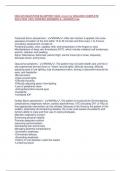NSG 223 MILESTONE BLUEPRINT 2022 UPDATED for 2024/2025 COMPLETE
SOLUTION 100% VERIFIED ANSWERS A+ GRADED Free
Fractured femur assessment - ✔✔ANSW✔✔..After skin traction is applied, the nurse
assesses circulation of the foot within 15 to 30 minutes and then every 1 to 2 hours.
Circulatory assessment consists of:
Peripheral pulses, color, capillary refill, and temperature of the fingers or toes.
Manifestations of deep vein thrombosis (DVT), which include unilateral calf tenderness,
warmth, redness, and swelling.
Signs: Edematous, deformed, painful thigh, cannot move hip or knee, frequently
develops shock, ecchymosis
Glaucoma symptoms - ✔✔ANSW✔✔..The patient may not seek health care until he or
she experiences blurred vision or "halos" around lights, difficulty focusing, difficulty
adjusting eyes in low lighting, loss of peripheral vision, aching or discomfort around the
eyes, and headache.
-Blurred vision
-Halos around lights
-Difficulty focusing
-Difficulty adjusting eyes in low lighting
-Loss of peripheral vision
-Aching/discomfort around eyes
-Headache
-Increased IOP
Guillan Barre assessment - ✔✔ANSW✔✔..The patient is monitored for life-threatening
complications (respiratory failure, cardiac dysrhythmias, VTE [including DVT or PE]) so
that appropriate intervention can be initiated. Because of the threat to the patient in this
sudden, potentially life-threatening disease, the nurse must assess the patient's and
family's ability to cope and their use of coping strategies.
Maintain respiratory function
Enhancing physical mobility
Promote adequate nutrition
Improving communication
Decreasing fear and anxiety
Managing potential complications
-Symmetric weakness
-Diminished reflexes
-Ascending weakness
-History of viral disease in past few weeks
-Lumbar puncture
, Ischemic stroke - ✔✔ANSW✔✔..Disruption of cerebral blood flow due to obstruction of
bloodvessels, neurons no longer able to maintain aerobic respiration and must switch to
anerobic respiration which generates a lot of lactic acid, building up PH, neurons inable
to product ATP.
CM: Numbness or weakness of the face, arm, leg, on one side of body
-confusion or change in mental status
trouble speaking or understanding speech
visual disturbances
difficulty walking, loss of balance, or dizziness
severe sudden headache
Causes: Large artery thrombosis
Small penetrating artery thrombosis
Cardiogenic embolic
Treat: TPA within 3 hours of symptoms
Diagnose: CT scan within 25 minutes or less from arrival in ED
Thrombolitic or embolic
Meningitis care - ✔✔ANSW✔✔..-Dexamethasone before abx
-Antibiotics
-Treat dehydration, shock, seizures
-If viral: bed rest, fluids, OTC meds
Precautions: droplet
Positive kernig sign (legs won't straighten) neck immobility, positive brudzinski sign
(when lift neck up, knees bend at same time), photophobia, rash, disorientation,
seizures,
First step: antibiotic care
MS and urinary retention - ✔✔ANSW✔✔..A neurogenic bladder results in urinary
retention or leakage. The patient may describe a sensation of bladder fullness or
incomplete bladder emptying. The pharmacological treatment of urinary retention is
administration of a cholinergic agonist
From Google:
Many multiple sclerosis (MS) patients are affected by urinary retention. Common
causes include neurogenic underactive bladder and/or bladder outlet obstruction from
detrusor sphincter dyssynergia
NG suction metabolic alkalossis - ✔✔ANSW✔✔..Loss of stomach HCL
Blood stream loses H ions and becomes alkalotic
CM: (Hypocalcemia) tingling in fingers/toes, dizziness, tetany (muscle cramping)
PH >7.45




